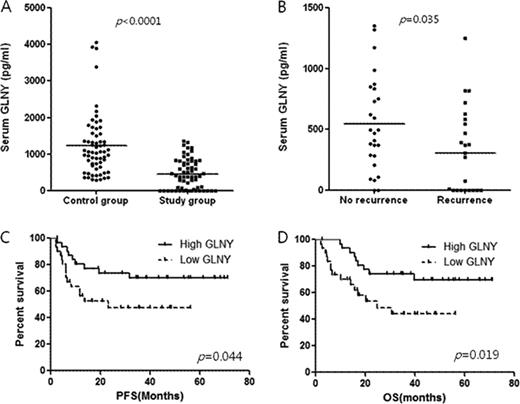Abstract
Abstract 1993
Granulysin, cytolytic molecules of cytotoxic T lymphocytes and NK cells, is synthesized as 9-kDa and 15-kDa molecule. 9-kDa granulysin is located intracellularly, whereas 15-kDa granulysin is continuously secreted. We investigated the association between pretreatment serum level of 15-kDa granulysin and prognosis in 63 patients with diffuse large B cell lymphoma (DLBL), initially treated by R-CHOP regimen.
The mean pretreament serum level of 15-kDa granulysin level of DLBL patients was significantly lower than that of healthy subjects (p<0.0001) (Figure 1A). To analyze the difference in pretreatment serum granulysin levels according to the underlying patients’ characteristics, they were dichotomized in a prognostically meaningful way. There were no significant differeces according to gender, age, performance, histology, stage, existence of B symptom, international prognostic index (IPI) risk group 7, LDH level, β2-microglobulin level, and response to R-CHOP treatment. Among the patients who achieved complete remission, however, the mean pretreatment serum 15-kDa granulysin level of the patients who experienced recurrence within three years was significantly lower than that of the patients without recurence (p=0.035) (Figure 1B).
When patients were sorted into two groups with the median pretreatment serum granulysin value (380 pg/ml), the high granulysin group showed significantly longer progression-free survival (PFS) and overall survival (OS) (p=0.044 and p=0.019, respectively) (Figure 1C-D). On univariate analysis for PFS of 1st line therapy, high IPI risk group (high/high-intermediate) (p<0.0001), the presence of B symptom (p<0.0001), high β2-microglobulin level (p=0.002), bulky disease (single lesion diameter >= 10cm) (p=0.017), and low pretreatment serum granulysin level (p=0.044) were shown to sinigicantly influence PFS unfavorably. However, multivariate analysis showed only IPI risk group to be the significant factor for PFS [p=0.001, hazard ratio(HR) 0.156, 95% CI, 0.053–0.456]. With regard to overall survival (OS), the high IPI risk group (p<0.0001), the presence of B symptom (p<0.0001), high β2-microglobulin level (p=0.002), bulky disease (p=0.012), and low pretreatment serum granulysin level (p=0.019) were shown to be significantly influential. Multivariate analysis showed that IPI risk group [p<0.0001, HR 0.082, 95% CI, 0.025 to 0.268], bulky disease (p=0.035, HR 0.337, 95% CI, 0.122 to 0.929), and pretreatment serum granulysin level (p=0.019, HR 0.038, 95% CI, 0.169 to 0.949) were found to be the significant risk factors for OS. Therefore, the impact of pretreatment serum 15-kDa granulysin level on OS was independent.
In conclusion, pretreatment serum level of 15-kDa granulysin might be a valuable independent marker to predict prognosis such as recurrence after response and overall survival in DLBL patients who received R-CHOP as frontline treatment.
No relevant conflicts of interest to declare.
Author notes
Asterisk with author names denotes non-ASH members.


